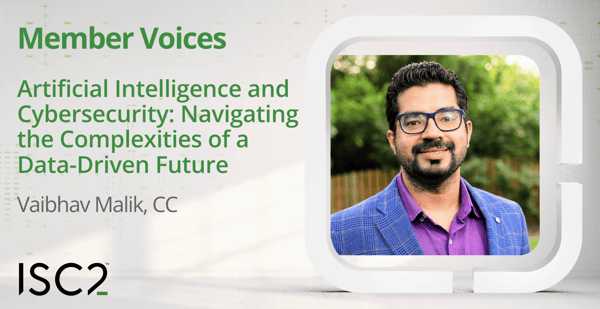Vaibhav Malik, CC, shares his observations as he explores the multifaceted impact of AI and ML on cybersecurity, looking at both legitimate and malicious applications of these technologies and their implications for organizations worldwide.
 Rapid advances in artificial intelligence (AI) and machine learning (ML)
have revolutionized how organizations approach cybersecurity. These
data-driven technologies have the potential to significantly enhance an
organization's defense strategies, streamline best practices, and optimize
day-to-day operations. However, the rise of AI and ML has also given birth
to new threats such as deepfakes, synthetic data and malicious chatbots, all
of which pose significant challenges to cybersecurity.
Rapid advances in artificial intelligence (AI) and machine learning (ML)
have revolutionized how organizations approach cybersecurity. These
data-driven technologies have the potential to significantly enhance an
organization's defense strategies, streamline best practices, and optimize
day-to-day operations. However, the rise of AI and ML has also given birth
to new threats such as deepfakes, synthetic data and malicious chatbots, all
of which pose significant challenges to cybersecurity.
Legitimate AI Cybersecurity Applications
One of the most significant benefits of AI and ML in cybersecurity is their ability to process and analyze vast amounts of data in real time or near real time, enabling organizations to detect and respond to threats theoretically more quickly and efficiently than by human analysis alone. Using advanced algorithms and pattern recognition techniques, AI-powered security systems can identify anomalies, suspicious activities, and potential vulnerabilities that might otherwise go unnoticed by human operators.
AI and ML can also automate security processes such as vulnerability scanning, patch management, and incident response, allowing security teams to streamline these time-consuming tasks and focus on more strategic initiatives.
Another key application of AI in cybersecurity is threat intelligence. AI-powered tools can scrape vast amounts of data from various sources – including dark web forums, social media platforms, and threat intelligence feeds – to identify emerging threats and vulnerabilities. By analyzing this data in real time, organizations can proactively adjust their defense strategies and implement preventive measures before attacks occur.
Malicious AI Applications
While AI and ML offer numerous benefits to cybersecurity, they also present new opportunities for malicious applications. As these technologies become more accessible and sophisticated, cybercriminals increasingly leverage them to create more convincing and harder-to-detect attacks.
One of the most concerning developments in this regard is the rise of deepfakes. In a recent incident, cybercriminals used a deepfake video to trick a company's employees into transferring a large sum of money to a fraudulent account. The video, created using advanced machine learning algorithms, depicted a senior executive giving instructions on how to make the transfer. This incident highlights the potential for deepfakes in social engineering attacks, such as spear-phishing campaigns or CEO fraud, to trick employees into divulging sensitive information or transferring funds to fraudulent accounts.
Synthetic data, another product of AI and ML, also presents significant risks to organizations. Cybersecurity researchers have demonstrated how synthetic data could bypass fraud detection systems by generating synthetic transaction data that mimic legitimate user behavior. This experiment underscores the potential for attackers to use synthetic data to mask their activities or evade detection, posing a serious challenge to traditional security controls.
Malicious chatbots, powered by AI and natural language processing (NLP), are another emerging threat in the cybersecurity landscape. In recent phishing campaigns, attackers have used AI-powered chatbots to impersonate IT support staff or other trusted entities, tricking employees into revealing their login credentials and other sensitive information. These chatbots, designed to engage in convincing conversations with humans, can adapt to different questions and responses, making it difficult for employees to realize they are interacting with a malicious entity.
Addressing the Cybersecurity Challenges of AI
The most proactive organizations I have worked for have adopted proactive and holistic approaches, encompassing technological and human factors to navigate the complexities of AI and ML in cybersecurity. This has involved implementing robust AI governance frameworks, fostering a culture of security awareness, and collaborating with the broader cybersecurity community to develop effective countermeasures against malicious AI.
One of the critical steps in this direction has been establishing clear guidelines and policies for the responsible use of AI and ML in cybersecurity. In each case, I had to ensure that these technologies were deployed transparently, accountably and ethically, with appropriate safeguards to prevent misuse or unintended consequences. The National Institute of Standards and Technology (NIST) has published a comprehensive framework for AI governance, which guides conducting regular audits and assessments of AI systems, implementing strict access controls and data governance practices, and providing ongoing training and education for employees on the risks and responsibilities associated with AI and ML.
I also believe that organizations must invest in research and development of advanced AI-based defense mechanisms to counter the growing threat of malicious AI. This includes exploring techniques such as adversarial machine learning, which involves training AI models to identify and neutralize manipulated or synthetic data. IBM Research has made significant strides in this area, developing an adversarial machine learning platform called the Adversarial Robustness Toolbox (ART) that helps organizations build more resilient AI systems capable of withstanding attacks from malicious actors.
Equally important, in my view, is fostering a culture of security awareness and digital literacy among employees and stakeholders. As AI and ML technologies become more prevalent in the workplace, individuals must understand the potential risks and know how to recognize and respond to AI-driven threats. Regular training and awareness programs can help employees develop the skills and knowledge needed to identify deepfakes, synthetic data, and malicious chatbots, reducing the risk of successful social engineering attacks.
Finally, I’ve found that collaboration and information sharing within the cybersecurity community are essential to addressing the challenges posed by AI and ML. Organizations such as the Cyber Threat Alliance and the AI Incident Database provide platforms for cybersecurity professionals to share threat intelligence, best practices, and lessons learned, collectively strengthening their defenses and developing more effective strategies for mitigating the risks associated with these technologies.
Conclusion
The impact of AI and ML on cybersecurity is profound and complex, presenting opportunities and challenges for organizations worldwide. While these data-driven technologies offer tremendous potential for enhancing defense strategies, streamlining best practices, and optimizing day-to-day operations, they also give rise to new threats in the form of deepfakes, synthetic data, and malicious chatbots.
To successfully navigate this complex landscape, we cyber security professionals must adopt a proactive and holistic approach that combines technological innovation with human factors. By implementing robust AI governance frameworks, fostering a culture of security awareness, and collaborating with the broader cybersecurity community, organizations can harness the power of AI and ML to strengthen their defenses while mitigating the risks posed by malicious applications.
As we move into an increasingly data-driven future, we must remain vigilant and adaptable in the face of evolving threats. By embracing responsible innovation, investing in research and development, and prioritizing the ethical use of AI and ML, we can build a more secure and resilient cybersecurity landscape that benefits organizations and individuals alike. The path ahead has its challenges. Still, by working together and learning from our experiences, both successes and failures, we can navigate the complexities of this new era and create a safer digital world for all.
Vaibhav Malik, CC, has 12 years of experience in networking, security, and cloud solutions. Vaibhav has held technical and business roles, with responsibility for designing and implementing Zero Trust security architectures for global customers.
- Visit our AI Appreciation Day page for more AI information, research and resources
- ISC2 has an on-going program of in-person and live virtual AI workshop experiences, helping professionals to develop the AI skill set for technology and regulatory implementation
- ISC2 Spotlight Webinar: AI Panel Discussion: Opportunities, Risks and Governance… oh my!


